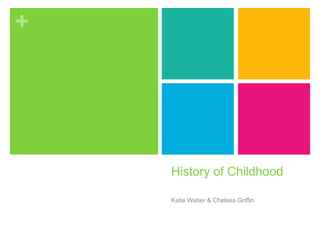Ed455 childhoodtimeline
- 1. + History of Childhood Katie Weber & Chelsea Griffin
- 2. + Middle Ages   They are seen as “objects” instead of their own persons.  Middle Ages First ideas of childhood emerge. Ex: Virgin and Child 15c  The main focus is on the mother, not the child.
- 3. + 17th and 18th century In these centuries, children were seen as “miniature adults” as you can see in the picture. They were part of community life because they were given jobs at a very young age.
- 4. + Beginning 17th Century ÔÅÆ Children are beginning to be seen as a central part of the family. ÔÅÆ In paintings from this era the child is shown as the main part of the picture with the parents surrounding them.
- 5. + 18th Century Children are beginning to be seen as individuals, but they were often portrayed as vulnerable and fragile, but sometimes as active and intelligent and free.
- 6. + 19th Century  Children are seen as a inferior social class.  They don’t have their own voice, and parents/guardians make all the decisions for them
- 7. + 20th Century  Children are getting a voice  Society is slowly starting to see them as their own being with their own ideas and opinions.  Still have a ways to go, but we’re getting there.







